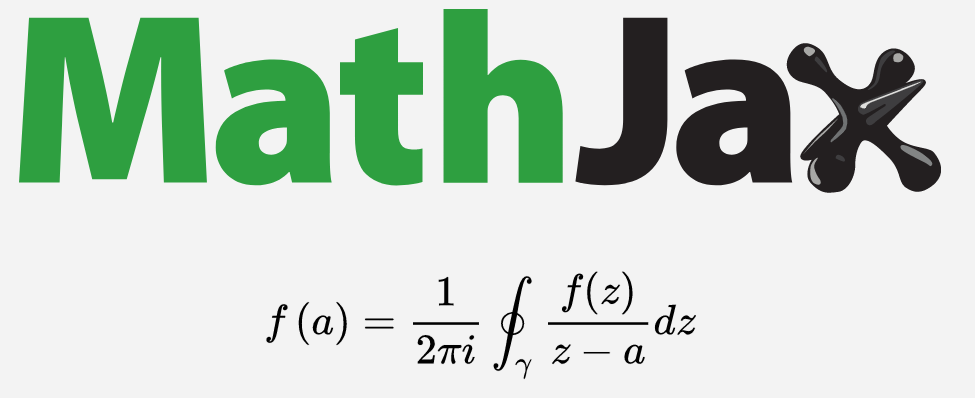In früheren Blogs habe ich einige Möglichkeiten zur Einbindung von mathematischen Formeln mit LaTeX vorgestellt. Eine andere, relativ neue Möglichkeit übergibt die Arbeit des Renderns an MathJax, ein Javascript Applet: Mathjax enables enables rendering of embedded latex or mathml in HTML pages.

Das Applet wird vom Webserver oder aus der Cloud heruntergeladen. Die Übersetzung vom LaTeX Code erfolgt dann im lokalen Browser und nicht mehr auf dem Server. Als Vorteil davon ist keine LaTeX-installation auf dem Server nötig; nachteilig sind die Lade- und Renderingzeiten auf dem Endgerät.
Für WordPress gibt es zwei Plugins Mathjax-LaTeX und Simple-Mathjax. Das erste Plugin wurde hier ins WordPress geladen und der gleiche Code wie für den Test von QuickLaTeX hineinkopiert. Im Code des Blogs musste nur irgendwo mathjax in eckigen Klammern eingefügt werden.
Dabei habe ich festgestellt:
- TikZ ist nicht enthalten (Beispiel 3: undefined Warnung). Die ist sehr schade, aber technisch nachvollziehbar.
- einzelne spezielle LaTeX-Kommandos auch nicht, wofür es problemlos Ersatz gibt.
Zum Beispiel habe ich \image als Bezeichnug für die Bildmenge ersetzen müssen. Das ist kein standard Befehl. - inline Formeln werden nicht erkannt, da sich hier das Mathjax Plugin und Quicklatex in die Quere kommen. Entweder aktiviert man dies in Mathjax – dann übernimmt Mathjax alle inline Formeln – oder benützt den Shortcode
latex. Das Einrahmen mit einfachen $-Zeichen funktioniert hier nicht, im Gegensatz zu QuickLaTeX. Siehe Beispiel 2 und 4. - man kann auch mit QuickLaTeX mischen, indem man den Code
latexpageeinfügt. Ob das wohl gut geht?! Auf dieser Seite wurden so die inline Formeln durch QuickLaTeX erkannt.
(Beispiel 1)
You may embed latex using a variety of different syntaxes. The shortcode (https://codex.wordpress.org/Shortcode_API) syntax is preferred. So ![]() will work out of the box. This also forces loading of mathjax.
will work out of the box. This also forces loading of mathjax.
(Beispiel 2)
Euler-Poincaré-Charakteristik eines Kettenkomplexes
Unter einem endlichen Kettenkomplex C versteht man eine Folge von Homomorphismen $$ 0\stackrel{f_{n+1}}{\longrightarrow} V_n\stackrel{f_n} {\longrightarrow}\cdots\stackrel{f_2}{\longrightarrow} V_1\stackrel{f_1} {\longrightarrow} V_0\stackrel{f_0}{\longrightarrow} 0 $$ mit der Eigenschaft ![]() , d.h.
, d.h. ![]() . Der Quotientenvektorraum $$ H_i(C)\: = \: {\rm Kern}\: f_i / {\rm Bild} f_{i+1}$$ heisst die i-te Homologie des Komplexes. Man beweise: Sind alle
. Der Quotientenvektorraum $$ H_i(C)\: = \: {\rm Kern}\: f_i / {\rm Bild} f_{i+1}$$ heisst die i-te Homologie des Komplexes. Man beweise: Sind alle ![]() endlichdimensonal, so gilt: $$ \sum_{i=0}^{n}(-1)^i\dim V_i = \sum_{i=0}^{n}(-1)^i\dim H_i(C)$$
endlichdimensonal, so gilt: $$ \sum_{i=0}^{n}(-1)^i\dim V_i = \sum_{i=0}^{n}(-1)^i\dim H_i(C)$$
Bemerkung: diese Wechselsumme heisst Euler-Poincaré-Charakteristik des Komplexes ![]() und wird mit
und wird mit ![]() bezeichnet.
bezeichnet.
(Beispiel 3)
Bilder mit tikz/pgfplots
Mit etwas Umstellungen im Code können auch Bilder mit tikz berechnet werden.
\begin{tikzpicture} [+preamble] \usepackage{tikz} \usepackage{pgfplots} \pgfplotsset{compat=newest} [/preamble] \begin{axis} \addplot3[surf,domain=0:360,samples=40] {cos(x)*cos(y)}; \end{axis} \end{tikzpicture}
(Beispiel 4)
Symplectic mappings of Sobolev Class
Let $\Omega\subset\RR^{2n}$, $n\ge 1$, be a domain.
A mapping $f\in W^{1,2n}_{loc}(\Omega,\RR^{2n})$ is symplectic (with respect to the standard symplectic form $\omega_0$) if
\begin{equation}Df(x)^TJDf(x)=J\qquad \textrm{for almost every x} \in\Omega.\label{syso1}\end{equation}
The symplectic mappings are special mappings of finite dilatation and thus are covered by the following main theorem.
Let $f\in W^{1,n}_{loc}(\Omega,\RR^{n})$ be a mapping of finite dilatation. Then
- $f$ has a continuous representative (also called $f$) satisfying
$$|f(x)-f(y)| \le C(n)||Df||_{L^n}\left(\log\frac{2}{|x-y|}\right)^{-1/n}\quad x,y\in K\subset\Omega\textrm{ compact},$$ - $f$ is differentiable pointwise almost everywhere in the ordinary sense,
- $f$ satisfies Lusin’s conditions $(N)$ and $(N^{-1})$, i.e. the image of a set with zero Lebesgue $n$-measure is a set of zero measure and also the preimage of a zero-set is a zero-set.